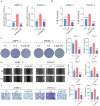The acidic microenvironment promotes pancreatic cancer progression via the lncRNA-LOC100507424/E2F1/FOXM1 axis
- PMID: 40211195
- PMCID: PMC11984246
- DOI: 10.1186/s12885-025-14073-4
The acidic microenvironment promotes pancreatic cancer progression via the lncRNA-LOC100507424/E2F1/FOXM1 axis
Abstract
Pancreatic cancer is highly aggressive and sensitive to acidic microenvironments, which promote cancer cell survival and invasion. Long non-coding RNAs (lncRNAs) play crucial roles in cancer biology, helping cells adapt to microenvironmental changes, but their functions in the acidic microenvironment of pancreatic cancer are understudied. This study investigated the role of lncRNA LOC100507424 in pancreatic cancer, previously linked to glioma stem cells. Clinical specimens and cell line models cultured under acidic conditions showed that LOC100507424 was upregulated in pancreatic cancer tissues and further increased in acidic environments. Functional assays demonstrated that knockdown of LOC100507424 inhibited cell proliferation, invasion and metastasis. Mechanistically, LOC100507424 transcriptionally regulated FOXM1 expression through its interaction with E2F1. In vivo studies confirmed that LOC100507424 promoted tumor growth in nude mice. These findings highlight the significance of lncRNAs in the acidic microenvironment of pancreatic cancer and suggest potential therapeutic targets.
Keywords: Acidic microenvironment; Cancer progression; LOC100507424; LncRNA; Pancreatic cancer.
© 2025. The Author(s).
Conflict of interest statement
Declarations. Competing interests: The authors declare no competing interests.
Figures







Similar articles
-
Long noncoding RNA Linc00337 functions as an E2F1 co-activator and promotes cell proliferation in pancreatic ductal adenocarcinoma.J Exp Clin Cancer Res. 2020 Oct 14;39(1):216. doi: 10.1186/s13046-020-01725-5. J Exp Clin Cancer Res. 2020. PMID: 33054826 Free PMC article.
-
FOXM1-Driven CKS1B Upregulation Promotes Pancreatic Cancer Progression and Therapeutic Resistance.Int J Biol Sci. 2025 Jan 13;21(3):1047-1064. doi: 10.7150/ijbs.105289. eCollection 2025. Int J Biol Sci. 2025. PMID: 39897042 Free PMC article.
-
A new tandem repeat-enriched lncRNA XLOC_008672 promotes gastric carcinogenesis by regulating G3BP1 expression.Cancer Sci. 2024 Jun;115(6):1851-1865. doi: 10.1111/cas.16172. Epub 2024 Apr 5. Cancer Sci. 2024. PMID: 38581120 Free PMC article.
-
lncRNA-PLACT1 sustains activation of NF-κB pathway through a positive feedback loop with IκBα/E2F1 axis in pancreatic cancer.Mol Cancer. 2020 Feb 21;19(1):35. doi: 10.1186/s12943-020-01153-1. Mol Cancer. 2020. PMID: 32085715 Free PMC article.
-
Long non-coding RNA NNT-AS1 sponges miR-424/E2F1 to promote the tumorigenesis and cell cycle progression of gastric cancer.J Cell Mol Med. 2018 Oct;22(10):4751-4759. doi: 10.1111/jcmm.13726. Epub 2018 Jul 14. J Cell Mol Med. 2018. PMID: 30006956 Free PMC article.
References
-
- Stoop TF, Theijse RT, Seelen LWF, Koerkamp G, van Eijck B, Wolfgang CHJ, van Tienhoven CL, van Santvoort G, Molenaar HC, Wilmink IQ, Del Chiaro JW, Katz M, Hackert MHG, Besselink T, International Collaborative Group on Locally Advanced Pancreatic Cancer. Preoperative chemotherapy, radiotherapy and surgical decision-making in patients with borderline resectable and locally advanced pancreatic cancer. Volume 21. Nature reviews. Gastroenterology & hepatology; 2024. pp. 101–24. - PubMed
MeSH terms
Substances
Grants and funding
LinkOut - more resources
Full Text Sources
Medical
Miscellaneous

